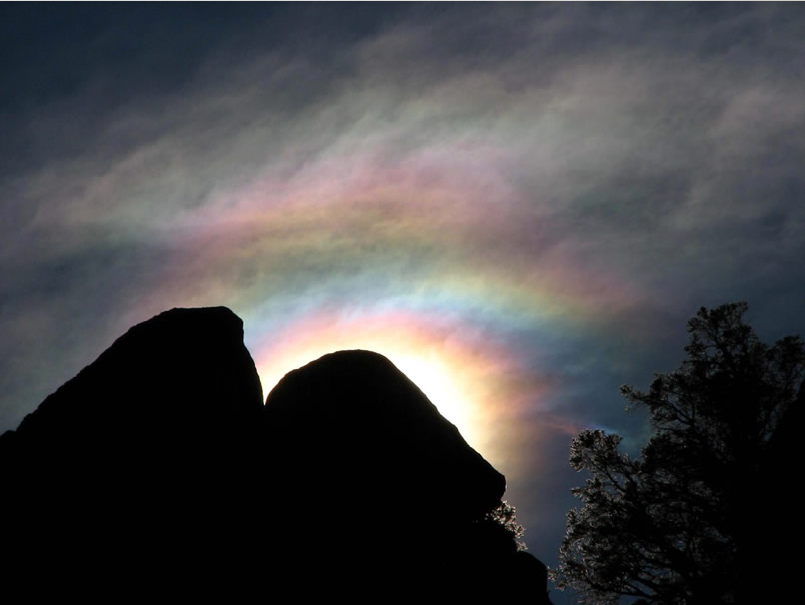Solar Corona
Solar Corona: A Spectacular Atmospheric Phenomenon
The solar corona is a breathtaking optical phenomenon that occurs during a total solar eclipse. It is a pearly white halo of light that surrounds the dark silhouette of the moon as it passes in front of the sun. This celestial spectacle is caused by the scattering of sunlight by tiny water droplets or ice crystals in the Earth's atmosphere.
The Science Behind the Solar Corona
The corona is formed when sunlight passes through the Earth's atmosphere and interacts with these microscopic particles suspended in the air. The scattering of light by these particles creates a diffraction pattern, causing the light to spread out and form a circular shape around the sun. The size and shape of the corona can vary depending on the size and distribution of the particles in the atmosphere.
Changing Droplet Sizes and Colorful Displays
One fascinating aspect of the solar corona is that its appearance can change based on the size and variability of the water droplets or ice crystals in the atmosphere. When the droplet size becomes more variable, the corona can exhibit non-circular rings and an iridescent effect. This occurs because the different sizes of droplets scatter light differently, leading to a chaotic mix of colors within the corona.
Iridescent Clouds: A Related Phenomenon
The iridescent cloud mentioned earlier is closely related to the solar corona. These clouds also form due to the scattering of light by water droplets or ice crystals in the atmosphere. When sunlight interacts with these particles, it undergoes diffraction, resulting in a beautiful display of vibrant colors. Iridescent clouds are often seen near or around the corona during a total solar eclipse.
Observing and Photographing the Solar Corona
Witnessing a solar corona during a total solar eclipse is an awe-inspiring experience. To safely observe this phenomenon, it is crucial to use proper eye protection such as eclipse glasses or solar filters. These devices allow you to view the corona without damaging your eyes. Many photographers also capture stunning images of the corona by using specialized equipment and techniques to capture the intricate details and vibrant colors.
The Significance of the Solar Corona
The solar corona provides scientists with valuable information about the sun's outer atmosphere, known as the solar atmosphere. By studying the corona during a total solar eclipse, researchers can gather data on its temperature, density, and magnetic fields. This information helps deepen our understanding of the sun's behavior and its impact on space weather, including phenomena like solar flares and coronal mass ejections.
Beyond Total Solar Eclipses
While total solar eclipses offer the most dramatic views of the solar corona, this phenomenon can also be observed under different circumstances. For example, during partial solar eclipses or even in certain atmospheric conditions, such as when the sun is low on the horizon, a faint corona may become visible. These instances provide opportunities for enthusiasts and researchers to study and appreciate this captivating atmospheric display.
In conclusion, the solar corona is a mesmerizing atmospheric optics phenomenon that occurs during a total solar eclipse. It is formed by the scattering of sunlight by tiny particles in the Earth's atmosphere, creating a circular halo of light around the sun. The variability in droplet sizes and ice crystals leads to non-circular rings and iridescent effects within the corona. Studying the corona provides valuable insights into the sun's outer atmosphere and its influence on space weather. Whether observed during a total solar eclipse or under different conditions, the solar corona never fails to captivate and inspire awe in those fortunate enough to witness its ethereal beauty.

Solar Corona
Andrew Kirk imaged this corona in November '07.
The rings are non circular indicating a change in droplet size across the cloud. As the droplet size becomes more variable the colours become more chaotic and we have instead an iridescent cloud.
©Andrew Kirk, shown with permission.
Note: this article has been automatically converted from the old site and may not appear as intended. You can find the original article here.
Reference Atmospheric Optics
If you use any of the definitions, information, or data presented on Atmospheric Optics, please copy the link or reference below to properly credit us as the reference source. Thank you!
-
<a href="https://atoptics.co.uk/blog/solar-corona/">Solar Corona</a>
-
"Solar Corona". Atmospheric Optics. Accessed on December 22, 2024. https://atoptics.co.uk/blog/solar-corona/.
-
"Solar Corona". Atmospheric Optics, https://atoptics.co.uk/blog/solar-corona/. Accessed 22 December, 2024
-
Solar Corona. Atmospheric Optics. Retrieved from https://atoptics.co.uk/blog/solar-corona/.